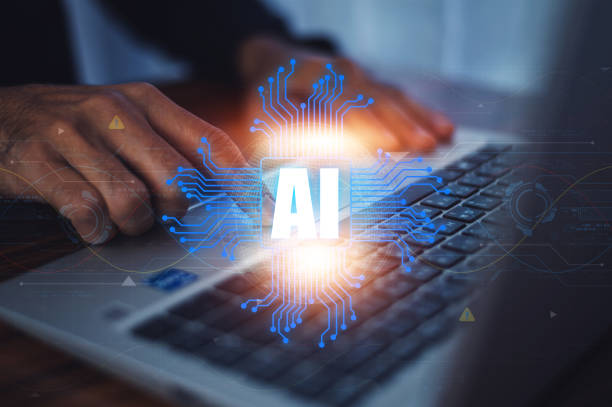What is Artificial Intelligence and How Does it Work?
### What is Artificial Intelligence and How Does it Work?
#Artificial_Intelligence (Artificial Intelligence or AI) is, in short, a branch of computer science that deals with building machines capable of performing tasks that typically require human intelligence.
These tasks include learning, reasoning, problem-solving, natural language understanding, and pattern recognition.
Artificial intelligence is not just a technology but a collection of techniques and approaches aimed at simulating and mimicking intelligent behaviors in machines.
These machines can learn through algorithms and existing data and make their own decisions based on this training.
[Artificial Intelligence](https://fa.wikipedia.org/wiki/%D9%87%D9%88%D8%B4_%D9%85%D8%B5%D9%86%D9%88%D8%B9%DB%8C) seeks to create systems that can solve complex problems and improve automatically.
The basis of [artificial intelligence](https://virgool.io/@mostafa.mirzaee/%D9%87%D9%88%D8%B4-%D9%85%D8%B5%D9%86%D9%88%D8%B9%DB%8C-%DA%86%DB%8C%D8%B3%D8%AA-%D9%88-%DA%86%DA%AF%D9%88%D9%86%D9%87-%DA%A9%D8%A7%D8%B1-%D9%85%DB%8C-%DA%A9%D9%86%D8%AF-q67j416s3775) is based on algorithms and mathematical models.
These algorithms allow machines to learn from data and identify patterns in them.
For example, a machine learning algorithm can learn how to distinguish cats from dogs from a set of labeled images (e.g., images of cats and dogs).
After training, the machine will be able to correctly categorize new images.
The learning process in artificial intelligence can be done in various ways, including supervised learning, unsupervised learning, and reinforcement learning.
Each of these methods has its own specific applications and benefits and is selected depending on the type of problem and the available data.
>Are you tired of your online store not generating as much revenue as its potential? Rasaweb, a specialist in designing professional online stores, will solve this problem forever!
>✅ Increased sales rate and revenue
>✅ High loading speed and unparalleled user experience
>⚡ Get free consultation on online store design
Types of Artificial Intelligence and Their Applications
### Types of Artificial Intelligence and Their Applications
[Artificial intelligence](https://www.techtarget.com/searchenterpriseai/definition/AI-Artificial-Intelligence) has different types, each with its own characteristics and applications.
One common classification is dividing artificial intelligence into two general categories: Narrow AI and General AI.
Narrow AI, also known as weak AI, is designed to perform specific tasks.
For example, a facial recognition system or a movie recommendation system are examples of Narrow AI.
These systems perform very well in their task, but they cannot perform other tasks.
In contrast, General AI, also known as strong AI, has cognitive abilities similar to humans.
A General AI system can learn, understand, and act independently in various fields.
Currently, General AI is still in the research stages, and no complete system with these capabilities exists.
[Artificial intelligence](https://www.ibm.com/topics/artificial-intelligence) has applications in various fields, including medicine, finance, transportation, education, and manufacturing.
In medicine, artificial intelligence can help diagnose diseases, develop drugs, and provide personalized care.
In finance, it can be used to detect fraud, manage risk, and provide investment advice.
In transportation, artificial intelligence can help develop self-driving cars and improve traffic.
In education, it can help provide personalized learning and assess student performance.
In manufacturing, it can help improve productivity, reduce costs, and increase product quality.
Machine Learning and Its Role in Artificial Intelligence
### Machine Learning and Its Role in Artificial Intelligence
Machine Learning (or ML) is one of the main sub-branches of [artificial intelligence](https://www.oracle.com/artificial-intelligence/machine-learning/) that allows machines to learn from data without explicit programming.
In other words, using machine learning algorithms, machines can identify patterns in data and make their own decisions based on these patterns.
Machine learning allows machines to improve their performance over time and with more data.
This learning process can be done automatically and without human intervention.
There are different types of machine learning algorithms, including Supervised Learning, Unsupervised Learning, and Reinforcement Learning.
In supervised learning, the machine is trained using labeled data.
For example, to train a machine to recognize images of cats and dogs, a set of labeled images (images of cats and dogs) is given to the machine.
Using this data, the machine learns how to identify the various features of cats and dogs and categorize new images based on these features.
In unsupervised learning, the machine is trained using unlabeled data.
In this case, the machine must automatically identify patterns in the data.
For example, a clustering algorithm can divide customer data into different groups based on their purchasing patterns.
In reinforcement learning, the machine learns how to achieve the best performance in a specific environment using trial and error.
In this case, the machine performs a series of actions and, based on the feedback it receives, learns which actions lead to the desired result.
Click here to preview your posts with PRO themes ››
| Machine Learning Algorithm | Description | Applications |
| ————————– | ————————————— | ——————————- |
| Linear Regression | Modeling the relationship between variables | Predicting price, sales |
| Logistic Regression | Predicting the probability of an event | Spam detection, disease detection |
| Decision Tree | Decision-making based on a series of rules | Fraud detection, risk assessment |
| Support Vector Machine (SVM) | Classifying data by finding the best separator | Image recognition, text recognition |
| Neural Networks | Modeling the human nervous system | Image recognition, natural language processing |
Deep Neural Networks and Their Applications
### Deep Neural Networks and Their Applications
Deep Neural Networks (or DNNs) are a type of neural network that has multiple layers (more than three layers).
These layers allow deep neural networks to identify more complex patterns in the data.
Deep neural networks have received much attention in recent years due to significant advances in areas such as image recognition, natural language processing, and machine translation.
[Artificial intelligence](https://www.tensorflow.org/tutorials/keras/classification) is used extensively in these systems.
Deep neural networks consist of different layers, each of which is responsible for extracting specific features from the data.
For example, in a deep neural network designed for image recognition, the initial layers may be responsible for detecting edges and corners, while the later layers may be responsible for detecting more complex objects such as faces and automobiles.
Deep neural networks are trained using Deep Learning algorithms.
These algorithms allow networks to identify complex patterns and improve their performance using vast amounts of data.
[Artificial intelligence](https://www.nvidia.com/en-us/deep-learning/what-is-deep-learning/) has advanced greatly in this field, and we are witnessing more innovations every day.
Deep neural networks have applications in various fields, including image recognition, natural language processing, machine translation, speech recognition, and computer games.
>Did you know that 85% of customers check your company’s website before any interaction?
>With Rasaweb, build a corporate website that deserves your credibility.
>✅ Increase customer credibility and trust
>✅ Attract high-quality leads
>⚡ Get a free website design consultation
Natural Language Processing (NLP) and Its Applications
### Natural Language Processing (NLP) and Its Applications
Natural Language Processing (or NLP) is a branch of artificial intelligence that allows machines to understand and process human language.
The main goal of NLP is to create systems that can communicate with humans in natural language.
These systems can perform tasks such as translating texts, answering questions, summarizing texts, and detecting emotions.
NLP uses various techniques to process human language, including Parsing, Semantic Analysis, and Pragmatics.
Syntactic analysis examines the structure of sentences and tries to identify the relationships between words.
Semantic analysis examines the meaning of words and sentences and tries to understand the overall concept of the text.
Linguistic analysis examines how language is used in different situations and tries to understand the speaker’s intent and purpose.
NLP has applications in various fields, including machine translation, chatbots, sentiment analysis, speech recognition, and text summarization.
Challenges and Limitations of Artificial Intelligence
### Challenges and Limitations of Artificial Intelligence
Although artificial intelligence has made significant advances, it still faces numerous challenges and limitations.
One of the main challenges is the need for vast amounts of high-quality data to train artificial intelligence models.
Artificial intelligence models need a lot of data to learn patterns and make accurate decisions.
If the training data is incomplete, incorrect, or unbalanced, the performance of artificial intelligence models is severely affected.
Another challenge is the interpretability of artificial intelligence models.
Many artificial intelligence models, especially deep neural networks, act as black boxes.
In other words, it is not clear how these models have reached a specific decision.
This can create problems in areas such as medicine and law, where there is a need to explain and justify decisions.
Another limitation of artificial intelligence is the lack of creativity and innovation.
Artificial intelligence can perform repetitive and routine tasks well, but it is still behind humans in solving complex problems and providing innovative solutions.
[Artificial intelligence](https://hai.stanford.edu/news/four-myths-about-ai) may also have trouble dealing with new and unexpected situations.
[Artificial intelligence](https://www.brookings.edu/research/10-myths-about-artificial-intelligence/) cannot currently completely replace humans but should be considered a powerful tool to help humans perform various tasks.
The Future of Artificial Intelligence and Its Impact on Human Life
### The Future of Artificial Intelligence and Its Impact on Human Life
[Artificial intelligence](https://sitn.hms.harvard.edu/flash/2023/the-impact-of-artificial-intelligence-on-human-life/) is advancing rapidly, and it is expected to have a profound impact on human life in the near future.
One of the most important impacts is the automation of jobs.
Artificial intelligence can automatically perform many repetitive and routine tasks, which can lead to a reduced need for human resources in some industries.
However, artificial intelligence can also create new job opportunities, especially in areas such as software development, data science, and artificial intelligence engineering.
Artificial intelligence can help improve the quality of human life in the future.
For example, artificial intelligence can help provide better health care, personalized learning, and safer and more efficient transportation.
Click here to preview your posts with PRO themes ››
However, the advancement of artificial intelligence can also create challenges.
One of the main challenges is the ethical issues related to artificial intelligence.
For example, how can we ensure that artificial intelligence systems act fairly and without discrimination? How can we determine responsibility for decisions made by artificial intelligence systems? These issues require careful discussion and review by experts and policymakers.
Another challenge is the security issues related to [artificial intelligence](https://www.eff.org/ai/threats).
Artificial intelligence systems can be vulnerable to cyberattacks and misused.
Therefore, creating secure and attack-resistant systems is of high importance.
In general, the future of artificial intelligence is bright and promising but requires careful attention and management of the challenges and issues related to it.
| Industry | Potential Impacts of Artificial Intelligence | Opportunities |
| ——– | —————————————————– | ——————————————— |
| Healthcare | More accurate disease diagnosis, personalized treatments | Developing new drugs, improving remote care |
| Transportation | Self-driving cars, intelligent traffic management | Reducing accidents, improving fuel efficiency |
| Finance | Fraud detection, automated financial advice | Reducing risk, increasing profitability |
| Manufacturing | Process automation, intelligent quality control | Increasing productivity, reducing costs |
| Education | Personalized learning, automated assessment | Improving learning, increasing access to education |
How to Learn Artificial Intelligence?
### How to Learn Artificial Intelligence?
Learning [artificial intelligence](https://www.coursera.org/courses?query=artificial%20intelligence) requires a combination of theoretical knowledge and practical skills.
To start, you can familiarize yourself with basic mathematical concepts such as linear algebra, calculus, and probability.
These concepts form the basis of many artificial intelligence algorithms.
Then, you can learn programming languages such as Python and R.
These languages are powerful tools for implementing artificial intelligence algorithms.
[Artificial intelligence](https://www.udacity.com/school/artificial-intelligence) Python is widely used in this field due to its simplicity and extensive libraries.
After familiarizing yourself with basic concepts and programming languages, you can start learning machine learning algorithms and neural networks.
Various educational resources are available for this purpose, including online courses, books, and scientific articles.
Online courses on platforms such as Coursera, Udacity, and edX can be a good starting point for learning artificial intelligence.
You can also strengthen your skills by participating in practical projects.
Participating in open-source projects or doing personal projects can help you better understand the concepts and applications of artificial intelligence.
In addition, attending conferences and workshops can help you connect with other experts and stay up-to-date with the latest advances.
Learning [artificial intelligence](https://www.edx.org/learn/artificial-intelligence) is a continuous process and requires patience and perseverance.
>Are you tired of your company’s website not being seen as it should and losing potential customers? Solve this problem forever with professional and effective website design by Rasaweb!
>✅ Increase brand credibility and gain customer trust
>✅ Attract targeted sales leads
>⚡ Contact us now for a free consultation!
Artificial Intelligence in Iran: Status and Prospects
### Artificial Intelligence in Iran: Status and Prospects
Artificial intelligence in Iran, like other countries around the world, is developing rapidly.
The Iranian government has identified [artificial intelligence](https://irannewsdaily.com/2024/01/irans-digital-economy-under-spotlight-at-10th-elecomp-exhibition/) as one of its main priorities in the field of information and communication technology.
In recent years, we have seen an increase in the number of startups and startups active in the field of artificial intelligence in Iran.
These companies operate in various fields such as natural language processing, image recognition, industrial automation, and data analysis.
Iranian universities are also conducting extensive activities in the field of education and research in artificial intelligence.
Many prestigious Iranian universities offer bachelor’s and master’s degrees in artificial intelligence.
However, [artificial intelligence](https://financialtribune.com/news/domestic-economy/119631/ai-roadmap-to-be-unveiled-in-6-months) in Iran also faces challenges.
One of the main challenges is the shortage of specialized and skilled personnel in this field.
To solve this problem, we need to invest more in training and educating specialized human resources.
Another challenge is the lack of investment in research and development in the field of [artificial intelligence](https://www.atlanticcouncil.org/blogs/iransource/irans-ai-strategy-can-it-catch-up/).
To compete with other countries, we need to increase investment in this area.
Despite these challenges, the outlook for artificial intelligence in Iran is bright and promising.
Given the existing potentials in the country, Iran is expected to become one of the leading countries in the field of artificial intelligence in the near future.
Click here to preview your posts with PRO themes ››
Useful Resources and Tools for Artificial Intelligence Developers
### Useful Resources and Tools for Artificial Intelligence Developers
[Artificial intelligence](https://www.mongodb.com/developer/products/mongodb-ai/ai-tools/) developers need various resources and tools to carry out their projects.
One of the most important resources is software libraries.
Libraries such as TensorFlow, Keras, PyTorch, and scikit-learn are powerful tools for implementing machine learning algorithms and neural networks.
These libraries provide various functions and classes for performing different tasks such as data pre-processing, model training, and performance evaluation.
In addition to libraries, there are other tools for developing [artificial intelligence](https://aws.amazon.com/machine-learning/tools/).
Integrated development environments (IDEs) such as Jupyter Notebook and Google Colaboratory are popular tools for writing and running code.
These environments provide various features such as a code editor, debugger, and graph display.
Also, cloud platforms such as Amazon Web Services (AWS), Google Cloud Platform (GCP), and Microsoft Azure offer various services for developing and deploying artificial intelligence models.
These services include computing resources, data storage, and model management tools.
In addition, various educational resources are available for [artificial intelligence](https://www.deeplearning.ai/programs/) developers, including online courses, books, scientific articles, and online forums.
Using these resources and tools can help artificial intelligence developers carry out their projects.
#### Frequently Asked Questions
| Question | Answer |
| ———————————————————— | ———————————————————————————————————————————————– |
| What is artificial intelligence? | It is the simulation of human intelligence in machines programmed to think like humans and mimic their actions. |
| What are the main branches of artificial intelligence? | These include machine learning, deep learning, natural language processing, computer vision, and robotics. |
| What is Machine Learning? | It is a branch of artificial intelligence that focuses on enabling systems to learn from data and identify patterns without explicit programming. |
| Mention examples of artificial intelligence applications in our daily lives. | Voice assistants (such as Siri and Alexa), recommendation systems in Netflix and Amazon, self-driving cars, and facial recognition software. |
| What is Deep Learning? | It is a subset of machine learning that uses multi-layered (deep) artificial neural networks to process large amounts of data. |
| What is Natural Language Processing (NLP)? | It is a branch of artificial intelligence that focuses on enabling computers to understand, interpret, and generate human language. |
| What are some ethical concerns related to artificial intelligence? | These include bias in data, privacy, job loss, and responsibility in case of errors. |
| What are the main benefits of artificial intelligence? | Increased efficiency, improved decision-making, automation of repetitive tasks, and discovery of complex patterns in data. |
| How is artificial intelligence used in the healthcare field? | In diagnosing diseases, discovering drugs, analyzing medical images, and providing personalized patient care. |
| How do you see the future of artificial intelligence? | It is expected to continue to develop at a rapid pace, affecting all aspects of human life, from industry to education and entertainment. |
**And other services of Rasaweb Advertising Agency in the field of advertising**
Intelligent UI/UX: A fast and efficient solution for user interaction with a focus on attractive user interface design.
Intelligent website development: Designed for businesses looking to increase sales by optimizing key pages.
Intelligent UI/UX: A creative platform to improve click-through rates with attractive user interface design.
Intelligent UI/UX: An effective tool for digital branding with the help of using real data.
Intelligent SEO: Transform sales with the help of using real data.
And more than hundreds of other services in the field of internet advertising, advertising consulting, and organizational solutions
Internet Advertising | Advertising Strategy | Advertorial
#### Resources
[What is Artificial Intelligence? From Zero to One Hundred Artificial Intelligence](https://www.aparat.com/v/YqG67)
,[What is Artificial Intelligence? Everything About AI](https://virgool.io/@mostafa.shahbazi/artificial-intelligence-f0z2t3b67r84)
,[Basic Artificial Intelligence Training](https://faradars.org/courses/fvai106-introduction-to-artificial-intelligence)
,[What is Artificial Intelligence and What Are Its Applications? Everything About AI](https://www.quera.org/career/blog/artificial-intelligence/)
? Transform and elevate your business in the online world with the professional services of Rasaweb Digital Marketing Agency. From [custom website design](https://share.google/mQBI2uMQ2UUYhTmkx) to SEO and social media management, we are with you to achieve your goals. Contact us today for consultation and solutions tailored to your business.
📍 Tehran, Mirdamad Street, next to the Central Bank, South Kazerun Alley, Ramin Alley, No. 6
✉️ info@idiads.com
📱 09124438174
📱 09390858526
📞 02126406207





